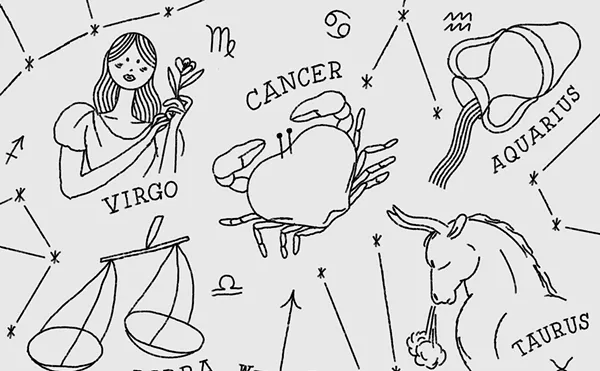
Audio By Carbonatix
[
{
"name": "GPT - Leaderboard - Inline - Content",
"component": "35519556",
"insertPoint": "5th",
"startingPoint": "3",
"requiredCountToDisplay": "3",
"maxInsertions": 100,
"adList": [
{
"adPreset": "LeaderboardInline"
}
]
}
]
Their paintings get seen by more people than do the works of most artists in the city. The exhibitions of their art are shown in every part of town, and often last for years. Yet they're virtually unknown.
"You'll sometimes see my work in the middle of, say, Puritan and Livernois, where you say, 'Wow, who is this? Why did they put this here?' says Michael Wilson. The 49-year-old is one of a handful of local artists whose medium is hand-painted advertisements, a quaint, dying craft largely supplanted nowadays by digitally printed vinyl ads pasted on billboards or strung on storefronts.
Hand-painted wall signs are labor-intensive, at the mercy of the rain and sunshine, and carry an old-fashioned image that some business owners would rather avoid. On the other hand, they're inexpensive, eye-catching, and long-lasting, and in a city mired in economic misery, they're still in demand.
"It makes them believe," Wilson says of his clients. "It gives them hope that they have a future."
Wall ads had their heyday in the first half of the last century, when national companies would employ painters to fan out through the countryside and paint company logos on barn walls large enough to be seen from the highway. The signage was standard in big cities for mom-and-pop stores. But as lighted signs and billboards became cheap and widespread, the signs — and the personality and artistry they project — became rare.
Some survive today as ghost signs, translucent leftovers of old ads featuring dated imagery or lettering that hints at their era. In Detroit, wall ads are found mostly along secondary roads in the neighborhoods, on the sides of small brick buildings. Some are ill-proportioned, crookedly lettered, or poorly drawn. Others are nothing more that a few colorful words scrawled next to a door.
But the best among them are little works of folk art, infused with artistic flair, colorful imagery, or distinct lettering, and their creativity ranges from subtle to spectacular.
The artists who paint them usually go by just one name — Klein, Norman, Patrick, Wilson, Scott, Young and Richard among them in Detroit. Usually it's their last name, but sometimes it's their first, painted in fine script with their phone number at the bottom of their work. Most are artists doing ads as a side job to make ends meet. On average, they get a few hundred dollars for a job.
Wilson is one of the city's most prolific sign painters. Hundreds of walls around town feature his work, from Dapper Tailoring on Greenfield south of Seven Mile to Kwanzaa Barbershop on Puritan west of Greenfield, where a field across the street features a dozen of his murals on wood planks. He employs a childlike simplicity, using bright, bold colors and cheerful cartoon characters. He's an art education major who's taught painting to elementary school students for a few years, so he just brings what he knows into his creations. A lot of his work is for child-oriented businesses, like party supplies or clowns.
"I love the colors," Wilson says. "The colors stand out. I think the colors and the shapes bring the art about, and you start putting characters into the designs." Canary yellows, apple reds, sky blues — his trademark is colors that are rich and intense. "A lot of people walk by and say they like my work. They see my work all over, they like the colors, they love the artwork."
If Wilson's style is straightforward, Patrick's is kaleidoscopic. His pieces, like the one for Anointed Hands salon on McNichols west of Wyoming, project color like a backlit prism.
"I try to make it as attractive and eye-catching as possible and integrate my own creativity," 51-year-old Kevin Patrick says. "They give me the information, and they give me creative license to make it look like I do, and for some reason they trust me to make it look beautiful." He calls his style "muralistic graffiti."
Patrick worked factory jobs for years until art gradually took over his time and led him to this career.
"I realized that I had a skill to a degree to do artwork, and I saw some guys painting in the sunshine, watching the pretty girls go by and getting paid for what they enjoyed doing, and I could not believe that it was possible for someone to do that. I was used to going to work all the time and not exercising my skills all the time. They were getting paid for it while they were free."
He's most proud of his outdoor mural at the Sugar N Spice Nursery School on Wyoming south of McNichols, a piece that livens up a drab space between two buildings.
"I drew like a fantasy playground, and that is a masterpiece, I must say," Patrick says. "I think the wall must be a thousand feet long and a million feet high. It has fantasy houses and sky and telephone wires and open doors, like cottages. I want to make the kids really feel comfortable to play back there and even have a subliminal effect on them that they were truly in that fantasy land."
But such labors of love are uncommon among the wall ads for liquor stores, dry cleaners and car washes that dominate the field. He paints a couple of those a week. "It's just a means to a financial end," he says. "I hate being locked down in the first place, but you have to pay the bills."
Scott Caudle has the same problem. He's a portrait and landscape artist who paints wall ads to fund his personal art, which he in turn has little time for as he paints signs to pay the bills. It's a frustrating loop. "I want to go back into the fine arts portraits, that's my heart," says Caudle, 60. "This right here, man, I hate doing this sometimes, but it pays the bills. I hate to say that."
He and other sign painters transform their frustration by incorporating art into their commercial work. A Caudle cartoon for a shipping company shows two retro-looking deliverymen smiling earnestly as they work. A Bridge Card portrayed on a Livernois liquor store by the painter known as Norman features the Ambassador Bridge and is issued to Britney Spears. A simple ad commissioned by a small tire shop wound up featuring a voluptuous blonde in a gown standing in front of a sparkling yellow Rolls Royce. Patrick made that one. "I love to paint beautiful women," he says with a sly smile. "That's my specialty. I really want to go that way someday."
Caudle just wants respect. He says some people look down on the profession, as they did years ago when sign painters were called "wall dogs" and had a reputation for being unruly transients. "They think you're a bunch of drug addicts and drunks, that you have to drink in order to keep a sturdy hand, which is not true," he says. "That's sort of the reputation." He still takes considerable pride, he says, in doing a quality job, in being a true artist, in proving the critics wrong.
The problem nowadays is the dominance of cheap banners, which dries up business and is rendering sign painting a lost art. "When I was coming up in it, and before vinyl letters started, it was very lucrative, but now it's kind of dying out," Caudle says. There are fewer customers to paint for too. "A lot of businesses have moved out of Detroit, or closed down." But like most artists, the sign painters carry on despite the little recognition, low pay and dwindling work. Sometimes, a passerby will stop and compliment their art as they paint. "I'm not Van Gogh or Degas by any stretch of the imagination," Patrick says, "but the people who come through, they love it."
Such moments, they say, make it worth all the time and effort.
"It makes it a little bit better, you know," Caudle says. "Like I'm somebody."
Detroitblogger John scours Detroit for Metro Times. Send comments to letters@metrotimes.com




